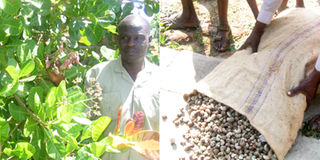‘My goal is for Uganda to become the leading producer of cashew nuts’

Erukana with a friend at his cashew nut plantation in wkaler village, Ngora District. Below, he shows some of the dried cashew nuts that he has not yet processed. Right, inspecting seedlings in the nursery. PHOTOS BY SIMON PETER EMWAMU.
What you need to know:
When Seeds of Gold started two years ago, the main story was about Joseph Ekillan Erukana, a cashew nut farmer. Here, he recounts how the story had a positive impact on his business.
Selected as one of the farmers from eastern Uganda for training on cashew nut by National Forestry Resources Research Institute (Naforri), Joseph Okillan Erukana is not only growing the crop but a champion for cashew nut.
His story was captured in the first issue of Seeds of Gold, in December 2012. Following the story, Erukana was approached by Simone Wims, a cashew importer from The Netherlands, to join hands so as to scale up cashew nut production in Lango.
Partners
So far, a total of 16,000 seedlings have been planted and they are yet to start fruiting. It is expected that the cashew nuts will be ready for harvest in 2016. Also, after the story, an NGO operating in Karamoja, the Karamoja Integrated Development programme (Kidep) partnered with him to train farmers in Apeitolim, Napak District. They planted 1,000 cashew nut trees, harvestable in one and half years.
Similarly, in Abim District, more than 3,000 trees have been planted under the same initiative. Ekurana supplied the seedlings each earning him Shs2,000. With such interest in cashew nut from various parties, Ekurana’s dream is for Uganda to become one of the leading cashew nut producers.
Vision
“Also, I acquired a larger size of land in Abim District unlike the plots I have at home in Ngora. I have so far planted 2,000 trees but my target is to have 10,000 trees,” he adds. Ekurana also reveals that from his conversations with Wims, his Dutch partner, there are plans to establish a cashew nut processing unit in Soroti District by 2018.
This is basing on realising quantities that can be used to produce cashew paste, kernels, juice, wine and other products. Keeping his vision intact, Ekurana affirms that Wims has already made orders from him for thousands of seedlings in 2015 for farmers in Lango and Teso regions.
More attention
“An interesting aspect is that he is willing to buy all grades of cashew nut from farmers,” he says. In addition, farmers from as far as West Nile, western and central Uganda have come to buy seedlings from his plantation.
He intends to travel to Naliendele Agricultural Research Institute in Tanzania for polyclonal seeds to fulfill the orders he has.
Ekurana, who once served as an agriculturist specialising in animal husbandry, believes his passion for cashew nut farming was “inherited” from his father Erukuna Emuron, who was growing it in the 1970s. He also feels that cashew nuts as a cash crop should receive the desired attention like any other crops from government under Naads programme. “The only pioneer plantations under Naforri in Soroti is where polyclonal seeds for distribution would have come from instead of relying on Naliendele,” he notes.
In his endeavour to promote cashew nut farming, Ekurana says he is in the process of writing a book. It will cover the history of cashew nuts in eastern and northern Uganda, how it is potentially a goldmine, and how farmers could fully exploit its cultivation.
Benefits
“It also grows best when intercropped with crops such as pulses, groundnuts, millets. This makes the best in terms of maximising limited space,” explains Ekurana about some of the advantages of the cashew nut tree.
On its nutritional benefits, he says cashew nuts are packed with soluble dietary fibre, minerals and various micro-nutrients that help protect people from diseases.
It is also rich in unsaturated fatty acids that help prevent coronary artery disease and strokes.
On the market, the price for cashew nuts has increased over the two years. In 2012, he was selling each kilogramme of processed cashew nut at Shs20,000. It is now at Sh25,000.
About cashew nuts
Cashew nuts, which that fall in the family of Anacardiaceae. They are an evergreen perennial crop found mostly in the tropics. It thrives on well-drained sandy soils with an average annual rainfall of at least 800mm, and an extended dry season to allow flowering.
Dr Shamte H.Shomari, in his book, Cashew Nut Production, advises that planting a spacing of 12m by 12m is recommendable. “The 12m-12m gives a total of 69 trees per hectare and that intercropping on that basis can be done for five years depending on the clone used and fertility of the soils,” he writes.
When marking and making the holes, it should be done two to three months prior. Each should be 60cm wide, 60cm deep and 60cm long to allow radial root growth. Then add a mix of manure and Nitrogen-Phosphorous-Calcium (NPK). The planting should be done at the start of the rainy season.
Young plants compete poorly with weeds, therefore fields should be kept free of weeds at all times.
Like other crops, cashews are also attacked by pests and diseases. Among these are powdery mildew, blight, dieback and Anthracnose.
Powdery mildew is one of the major fungal diseases. It is caused by Oidium anacardii, it attacks the tender parts of the plant, which can be controlled using sulphur dust or water-based fungicides.
Blight, which is also a fungal disease, attacks leaves and young nuts. This can be controlled through use of resistant cashew materials of either seed or grafted seedlings. Under good management, grafted cashews can start yielding after one year of transplanting. Before harvest, cashew trees should be free of weeds for easy picking of nuts.




